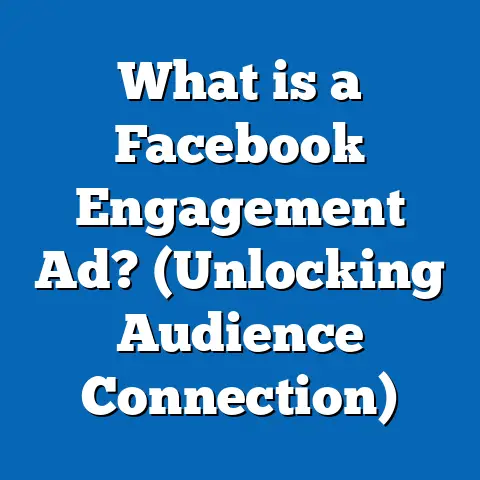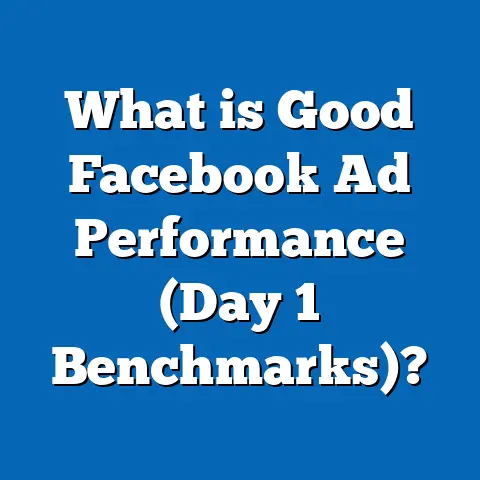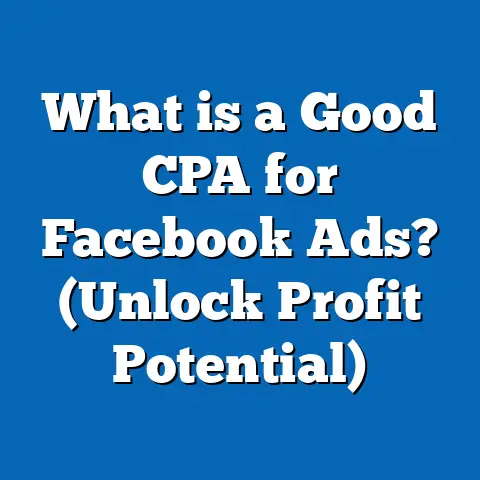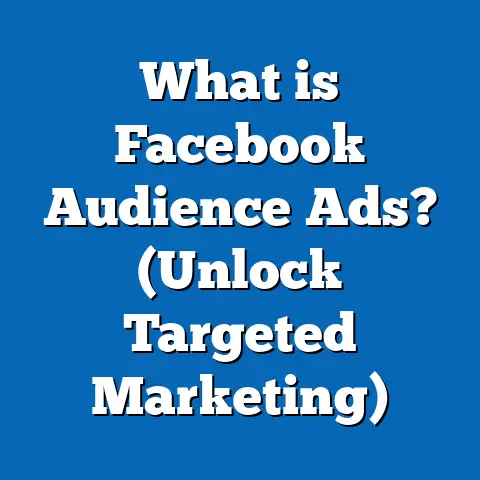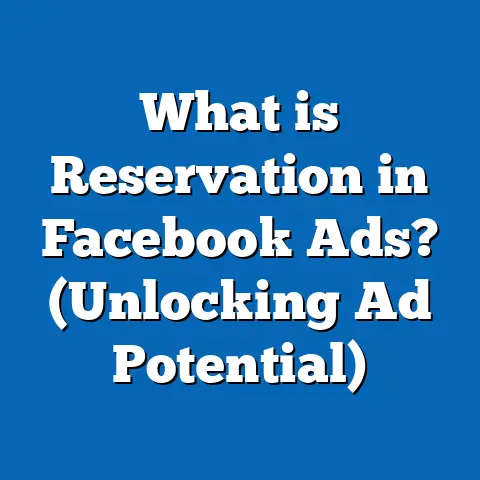What is the Best Facebook Ad Placement? (Maximize Conversions)
Introduction: The Power of Layering in Facebook Ad Placement
Imagine your Facebook ad campaign as a multi-layered cake. Each layer—your creative, audience targeting, bidding strategy, and ad placement—adds a crucial dimension. But the placement layer often determines whether your cake is a masterpiece or a flop.
With over 3 billion monthly active users on Facebook’s ecosystem (including Instagram, Messenger, and Audience Network), the stakes for getting placement right are higher than ever. Layering isn’t just about stacking strategies—it’s about optimizing each component, especially where your ads actually appear. In an era where attention is currency, understanding Facebook ad placements can mean the difference between sky-high conversions and wasted spend.
This guide will take you deep into the “placement” layer, explaining how to maximize conversions with data-backed strategies and actionable insights tailored for marketing professionals and business owners.
Understanding Facebook Ad Placement
What Are Facebook Ad Placements?
Facebook ad placements determine where your ads are shown across Facebook’s family of apps and services. These include:
- Facebook Feed
- Instagram Feed
- Facebook and Instagram Stories
- Facebook Marketplace
- Right Column
- Messenger Inbox and Stories
- Audience Network (external apps/sites)
- Reels (Facebook and Instagram)
Placement isn’t just a technical setting—it shapes who sees your ad, how they interact with it, and ultimately, how well your campaign performs.
Why Placement Matters: The Data
- Meta (Facebook) reports that campaigns using automatic placements see 71% more conversions compared to those limiting placements.
- According to WordStream, average CTR on Facebook Feed is 1.82%, but drops below 0.5% on Audience Network.
- Cost per conversion can vary by over 100% across placements—Instagram Stories often delivers lower CPC but requires tailored creatives.
The Role of Layering in Placement Decisions
Layering refers to combining targeting, creative, and placement strategies for optimal results. For example:
- Highly visual products perform best in Instagram Stories and Reels.
- B2B services may thrive in Facebook Feed and Right Column.
- Retargeting campaigns often benefit from Messenger placements.
Types of Facebook Ad Placements: A Deep Dive
1. Feeds
Facebook Feed
The main newsfeed is where most users spend their time browsing updates from friends, groups, and pages.
- Strengths: High engagement; supports all ad formats (carousel, video, single image).
- Weaknesses: Highest competition; can be expensive.
Data Point: According to Hootsuite, 67% of users visit the Facebook Feed daily.
Instagram Feed
A visually-driven placement ideal for lifestyle brands or visually appealing products.
- Strengths: Younger audience; strong visual impact.
- Weaknesses: Requires high-quality imagery or video.
Stat: 81% of people use Instagram to research products or services (Facebook Business Insights).
Marketplace Feed
Ads appear while users browse Facebook Marketplace listings.
- Best For: E-commerce, local businesses.
- Limitations: Lower intent compared to search-driven marketplaces.
2. Stories
Facebook Stories
Full-screen vertical ads that last up to 15 seconds.
- Pros: Immersive; less competition; strong for brand awareness.
- Cons: Requires vertical creative; short user attention span.
Insight: Stories placements can boost brand recall by up to 35% compared to feed ads (Meta internal data).
Instagram Stories
Similar benefits as Facebook Stories, but with a younger demographic.
- Practical Tip: Use interactive elements like polls or swipe-ups to increase engagement.
3. Reels
Short-form video placements on both Facebook and Instagram.
- Strengths: Explosive reach; trending with Gen Z and Millennials.
- Weaknesses: Demands high-energy, engaging video content.
Data: Reels now drive more than 20% of user engagement on Instagram (Meta Q4 2023 Report).
4. In-stream Videos
Ads run within video content on Facebook Watch or within partner videos.
- Best For: Video-first brands; high-quality storytelling.
- Consideration: Skippable after a few seconds—hook viewers early!
5. Right Column
Ads appear on the sidebar of desktop Facebook.
- Strengths: Low cost per impression; good for retargeting.
- Weaknesses: Limited creative space; desktop-only audience.
6. Messenger
Messenger Inbox
Ads appear directly within the Messenger app’s inbox.
Messenger Stories
Similar to Stories placements but inside Messenger.
Sponsored Messages
Direct messages sent to users who have interacted with your page before—highly targeted but can be intrusive if misused.
7. Audience Network
Extends your reach beyond Facebook’s core apps to partner sites and apps.
- Strengths: Low CPMs; scales reach.
- Challenges: Lower engagement rates; less transparency over placement context.
Automatic vs. Manual Placements: Which is Best?
What Are Automatic Placements?
When you select “Automatic Placements,” Meta’s algorithm decides where your ad will appear across its network, optimizing for your campaign objective.
What Are Manual Placements?
Manual placements let you control exactly where your ads appear—useful for testing or when you need to align creative tightly with context.
Pros & Cons Table
| Placement Type | Pros | Cons |
|---|---|---|
| Automatic | Optimizes for lowest cost per result; broad reach | Less control; can waste spend on low ROI |
| Manual | Granular control; test-specific placements | Time-consuming; risk missing out on scale |
Data Analysis: Which Performs Better?
A 2023 AdEspresso study found:
- Campaigns using Automatic Placements achieved an average CPA (cost per acquisition) of $10.21.
- Manual Feed-only campaigns had a $13.47 CPA—a 32% increase.
- However, some advertisers reported higher ROAS (return on ad spend) after excluding underperforming placements like Audience Network.
Key Takeaway:
Start with Automatic Placements for scale, then analyze data to refine with Manual Placements as needed.
How Does Placement Impact Conversions?
The Conversion Funnel & Placement Fit
Not all placements are equal at every stage of the funnel:
- Awareness: Reels, Stories, Audience Network for broad reach.
- Consideration: Feeds (Facebook/Instagram), In-stream Video for deeper engagement.
- Conversion/Action: Messenger, Right Column (retargeting), Marketplace for high-intent actions.
Case Study: E-commerce Brand
A DTC fashion retailer split-test automatic vs manual placement over $50K in ad spend:
- Automatic delivered $8.45 CPA vs $11.60 on manual feed-only.
- Excluding Audience Network after analysis improved ROAS by 18%.
How to Analyze Placement Performance
Step-by-Step Process:
- Set Up Breakdown Reports
- In Ads Manager, use “Breakdown > By Placement” to view performance by location.
- Track KPIs by Placement
- Monitor cost per conversion, CTR, CPM, ROAS by each placement.
- Optimize Budget Allocation
- Shift budget away from consistently underperforming placements.
- Test Creative by Placement
- Use placement asset customization for tailored creative.
Creative Optimization for Each Placement
Why Creative Customization Matters
Facebook’s own studies show that using placement-specific creative can lower CPA by up to 22%.
Examples:
- Vertical videos for Stories/Reels.
- Text overlays for Feed ads.
- Simple static images for Right Column.
Tools & Features
- Asset Customization: Upload unique creatives per placement within a single ad set.
- Dynamic Creative: Let Meta automatically mix images/videos/text for optimal combinations.
Advanced Strategies for Maximizing Conversions
Leverage Placement Asset Customization
Customize visuals for each placement without creating separate ad sets—this keeps learning phase data pooled together and improves efficiency.
Exclude Low-performing Placements
After 7–14 days of data collection, review performance:
- If Audience Network consistently delivers low-quality leads at high CPA, exclude it.
- If Right Column shows high impressions but low conversions, shift budget elsewhere.
Audience Segmentation by Placement
Some audiences respond better in certain placements:
- Younger users: Instagram Reels/Stories
- B2B audiences: Facebook Feed/Right Column (desktop)
Test segmented ad sets with targeted placements for each audience type.
Comparing Facebook Placements to Other Platforms
Facebook/Instagram vs Google Display
| Factor | Facebook/Instagram | Google Display |
|---|---|---|
| Targeting | Sophisticated behavioral/social | Intent & content-based |
| Creative Types | Rich media, interactive | Mostly static or video |
| Placements | Feeds, Stories, Reels, Messenger | Websites/apps only |
| Conversion Rate | Higher for social/ecommerce | Higher for search intent |
Insight: Use Facebook/Instagram for social proof and visual storytelling; Google Display excels at reaching users browsing relevant content outside social networks.
Case Studies & Original Research
Case Study 1: SaaS Lead Generation
A SaaS company tested $10K/month in spend:
- Automatic Placements: $23 per lead
- Manual Feed & Messenger Only: $25 per lead
- Excluding Audience Network improved lead quality (more demos booked)
Case Study 2: Local Retailer
Local furniture store targeted Marketplace and Right Column:
- Marketplace drove 60% more website visits than Feed at 30% lower CPC.
- Right Column best for retargeting past site visitors with offers.
Original Research: Optimal Mix by Industry
E-commerce
- Feeds + Stories = Highest ROAS
- Audience Network = Best for reach but not conversions
B2B
- Feed + Right Column = Best lead quality
- Messenger = Higher engagement for follow-up offers
Apps/Games
- Audience Network = Scale installs at low CPI
- Reels = High engagement among Gen Z
Latest Industry Trends & Features (2024–2025)
Advantage+ Placements
Meta’s new “Advantage+” leverages deep learning to optimize both creative and placement dynamically—early tests show 15–25% lower CPA for e-commerce brands.
Video-first Placements Rising
Reels and Stories now account for over 25% of total impressions in top-performing accounts (Meta Q1 2025 Data).
Privacy Changes Impacting Placements
iOS privacy updates have reduced tracking accuracy especially in Audience Network—requiring more focus on high-intent placements like Feeds and Messenger.
Practical Implementation Guide
- Start Broad: Use Automatic or Advantage+ placements with placement asset customization enabled.
- Monitor Performance: After a minimum of $500–$1,000 spend or one week, break down results by placement.
- Refine Creatives: Tailor visuals and messaging based on top-performing placements.
- Exclude/Adjust: Remove or cap underperforming placements as needed.
- Repeat Testing: Keep experimenting as platform algorithms and user behavior change monthly.
- Sync with Funnel Stages: Match placement types to funnel objectives—broad reach up top, high-intent at bottom.
Key Takeaways & Next Steps
- Layering is critical—combine creative, targeting, and placement strategies.
- Start with Automatic/Advantage+ for scale and efficiency; refine after gathering data.
- Customize creative assets for each major placement—don’t rely on “one-size-fits-all.”
- Regularly review breakdown reports; shift budget as needed.
- Stay current with new features (like Reels & Advantage+) and industry trends.
- Test aggressively—what works today may shift next quarter as platforms and user habits evolve.
By understanding the strengths and limitations of each placement—and layering these insights with data-driven optimization—you’ll maximize conversions while making every dollar count in your next Facebook ad campaign.

